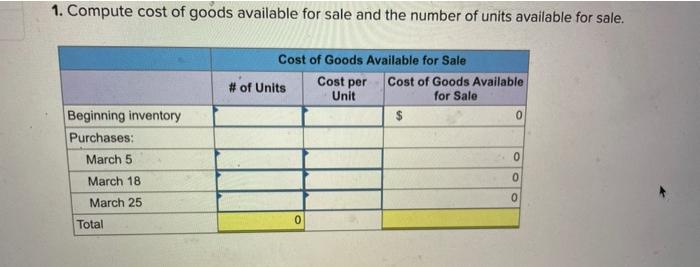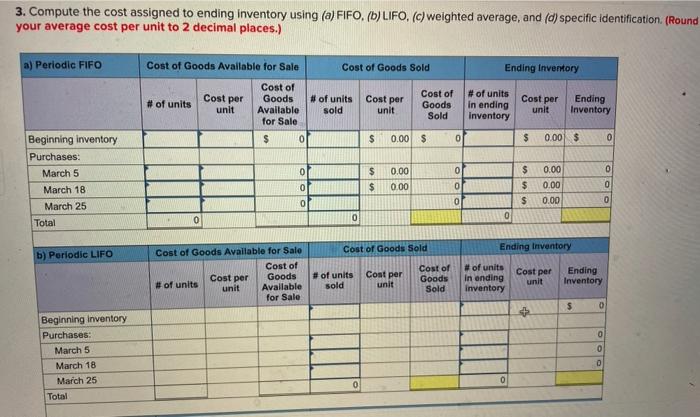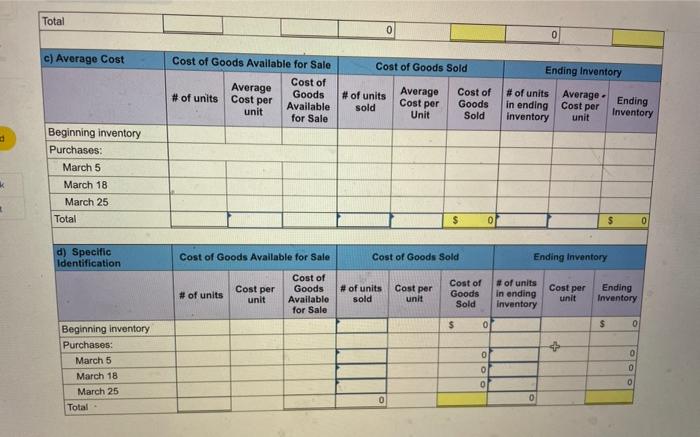Warnerwoods Company uses a periodic inventory system. It entered into the following purchases and sales transactions for March Units sold at Retail Units Acquired at Cost 170 units @ $60 per unit 470 units e $65 per unit Date Activities Mar. 1 Beginning inventory Mar. 5 Purchase Mar. 9 Sales Mar. 18 Purchase Mar. 25 Purchase Mar. 29 Sales Totals 490 units @ $95 per unit 260 units $70 per unit 340 unitse $72 per unit 300 units e $105 per unit 790 units 1,240 units For specific identification, the March 9 sale consisted of 90 units from beginning inventory and 400 units from the March 5 purchase; the March 29 sale consisted of 110 units from the March 18 purchase and 190 units from the March 25 purchase. 1. Compute cost of goods available for sale and the number of units available for sale. Cost of Goods Available for Sale Cost per Cost of Goods Available # of Units Unit for Sale 0 Beginning inventory Purchases: March 5 0 March 18 0 0 March 25 Total 2. Compute the number of units in ending inventory. Ending inventory units 3. Compute the cost assigned to ending inventory using (a) FIFO. (b) LIFO. (c)weighted average, and (d) specific identification (Round your average cost per unit to 2 decimal places.) a) Periodic FIFO Ending Inventory Cost of Goods Available for Sale Cost of Goods Sold Cost of Goods # of units Cost of # of units unit Available sold Goods unit for Sale Sold $ oi $ 0.00 $ 0 Cost per Cost per Cost per # of units In ending Inventory unit Ending Inventory $ 0.00 $ 0 0 $ 0 Beginning inventory Purchases: March 5 March 18 March 25 Total 0.00 0.00 0 $ 0 $ $ $ 0.00 0.00 0.00 0 0 0 0 0 0 0 Cost of Goods Sold Ending Inventory b) Periodic LIFO Cost of Goods Available for Sale Cost of Cost per Goods # of units unit Available for Sale #of units sold Cost per Cost of Goods Cost per unit # of units in onding Inventory unit Ending Inventory Sold $ 0 + 0 0 Beginning inventory Purchases: March 5 March 18 March 25 Total 0 0 0 Total 0 0 c) Average Cost Cost of Goods Sold Ending Inventory Cost of Goods Available for Sale Cost of Average Goods # of units Cost per Available unit for Sale # of units sold Average Cost per Unit Cost of Goods Sold #of units Average. in ending Cost per Inventory unit Ending Inventory Beginning inventory Purchases: March 5 March 18 March 25 Total k $ $ 0 d) Specific Identification Cost of Goods Available for Sale Cost of Goods Sold Ending Inventory Cost per # of units Cost of Goods Available for Sale # of units Cost per unit Cost of Goods Sold sold # of units in ending Inventory Cost per unit unit Ending Inventory $ 0 $ 0 0 0 Beginning inventory Purchases: March 5 March 18 March 25 Total 0 0 0 0 4. Compute gross profit earned by the company for each of the four costing methods. (Round your average cost per unit to 2 decimal places and final answers to nearest whole dollar) FIFO LIFO Weighted Average Specific Identification Sales Less: Cost of goods sold Gross profit $ 0 s 01$ 0 $












